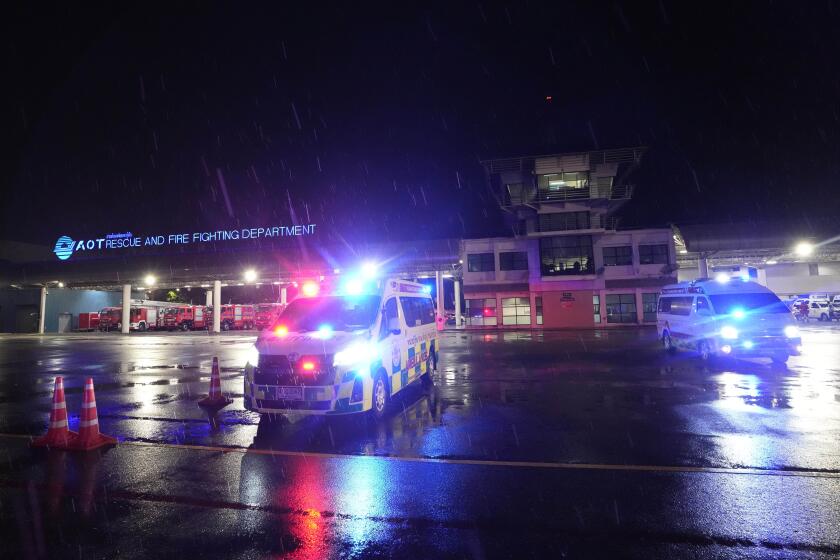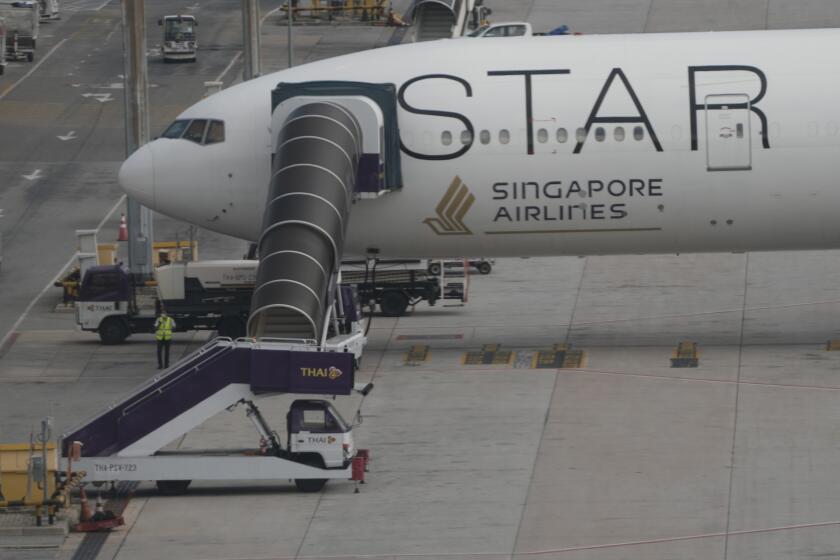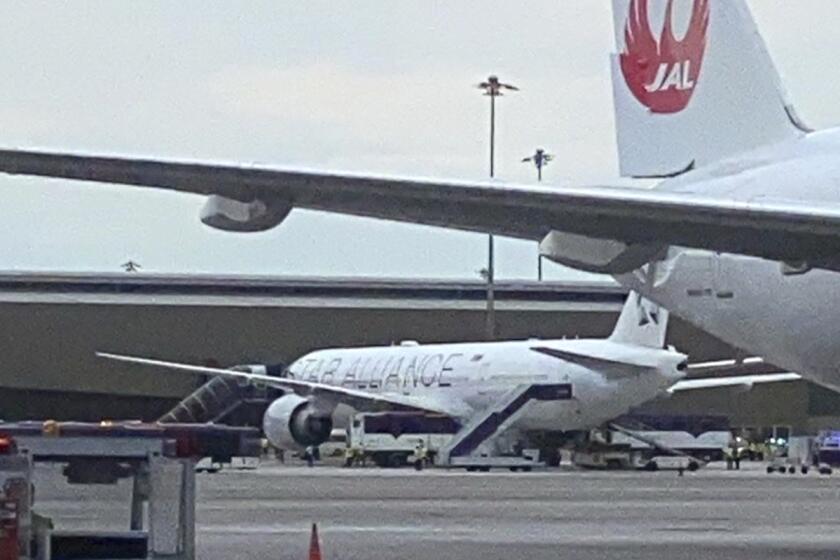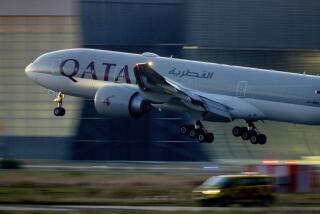Several injured passengers on turbulence-hit Singapore flight need spinal surgery, hospital says

- Share via
BANGKOK — Several of the more seriously injured people who were on the Singapore Airlines flight that hit severe turbulence earlier this week will need spinal surgery, a Bangkok hospital said Thursday.
Twenty people remained in intensive care after the Boeing 777, which was flying from London’s Heathrow airport to Singapore on Tuesday, ran into bad turbulence over the Andaman Sea, hurling items and passengers and crew members around the cabin. A 73-year-old British man died.
A public relations officer for Samitivej Srinakarin Hospital, where most of the 104 people hurt in the incident were treated, told the Associated Press that other local hospitals have been asked to lend their best specialists to assist in the treatments. He spoke on condition of anonymity under hospital policy.
Hospital director Adinun Kittiratanapaibool said at a news conference Thursday that none of the 20 patients in ICU were in life-threatening condition. They include six Britons, six Malaysians, three Australians, two Singaporeans and one person each from Hong Kong, New Zealand, and the Philippines.
Singapore Airlines says one of its flights hit severe turbulence over the Indian Ocean and descended 6,000 feet in a span of about three minutes.
Passengers have described the “sheer terror” of the aircraft shuddering, loose items flying and injured people lying paralyzed on the floor of the plane.
It remains unclear what exactly caused the turbulence that sent the plane, which was carrying 211 passengers and 18 crew members, on a 6,000-foot descent in about three minutes, after which the flight was diverted to Thailand.
In one of the latest accounts of the chaos on board, 43-year-old Malaysian Amelia Lim described finding herself face-down on the floor.
“I was so afraid ... I could see so many individuals on the floor, they were all bleeding. There was blood on the floor as well as on the people,” she told the online Malay Mail newspaper.
The woman who had been seated next to her was “motionless in the aisle and unable to move, likely suffering from a hip or spinal injury,” she added.
Thai authorities said the British man who died possibly had a heart attack. Passengers have described how the flight crew tried to revive him by performing CPR for about 20 minutes.
Singapore Airlines flight passengers described the aircraft shuddering, loose items flying and people wrenched so badly that 20 remain hospitalized in intensive care.
Among some 41 persons who had remained at Samitivej Srinakarin Hospital on Thursday morning, 22 had spinal or spinal cord damage, six had skull or brain injuries and 13 had damage to bones or internal organs, said hospital director Adinun. The 19 men and 22 women ranged in age from 2 years to 83.
Seventeen surgeries have already been performed — nine spinal surgeries and eight for other injuries, he said. Thirteen others injured in the incident remain at two other branches of the hospital.
Asked about the prognosis for the most serious cases, Adinun said it was too early to tell if any could suffer permanent paralysis, and doctors would have to observe whether muscle function recovered after surgery.
On Wednesday morning, a special Singapore Airlines flight took 143 uninjured or lightly hurt people onward to Singapore.
Most people associate turbulence with heavy storms, but the most dangerous type is so-called clear air turbulence. Wind shear can occur in wispy cirrus clouds or even in clear air near thunderstorms, as differences in temperature and pressure create powerful currents of fast-moving air.
A death and injuries on a Singapore Airlines flight highlight potential dangers to passengers and airplane crews of flying through extreme turbulence.
According to a 2021 report by the U.S. National Transportation Safety Board, turbulence accounted for 37.6% of all accidents on larger commercial airlines between 2009 and 2018. The Federal Aviation Administration, another U.S. government agency, has said there were 146 serious injuries from turbulence from 2009 to 2021.
Tourism and aviation expert Anita Mendiratta, who is based in London, said severe turbulence is “extremely unusual.”
She said passengers should listen to instructions to keep their seatbelts on, ensure that hand baggage is put away safely when not in use, and reduce items stowed in the overhead compartments.
“When there is turbulence, those doors can open and all of the items up top, whether it’s our hand baggage, our jackets, our duty free items, they become movable and they become a risk to us all,” she told the AP.
Ekvitthayavechnukul writes for the Associated Press. AP writer Eileen Ng in Kuala Lumpur, Malaysia, contributed to this report.
More to Read
Sign up for Essential California
The most important California stories and recommendations in your inbox every morning.
You may occasionally receive promotional content from the Los Angeles Times.











